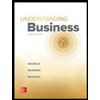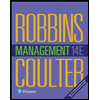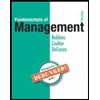
To determine:
The two overarching perspectives about management and three viewpoints under each.
Introduction:
The perspectives about management point out some of the crucial aspects for an organization that should be focused on. These viewpoints are the pathway towards the growth of the organization.
Answer to Problem 1UTC
Solution:
The two overarching perspectives about management are:
Historical perspective and Contemporary perspective
The historical perspective includes three viewpoints - classical, behavioral, and quantitative. The contemporary perspective includes systems, contingency, and quality management.
Explanation of Solution
The classical viewpoint in historical perspective puts focus on ways to manage work effectively and efficiently. The behavioral viewpoint under historical perspective focuses on motivating the employees towards goal by understanding human behavior. The third of the historical perspective suggests making use of quantitative techniques for management.
The system viewpoint in the contemporary perspective defines the organization as a combination of various subsystems that works together to achieve a common goal. The second viewpoint in contemporary perspective is contingency viewpoint which tells that a manager should work as per the situation and condition of an individual. The third is quality management viewpoint which explains that the management of quality is a crucial aspect and should be taken care of.
The organization and manager must consider the overarching perspective about management and all their viewpoints because it ultimately will help them to grow.
Want to see more full solutions like this?
- Question 2 The selected financial statements data of NGX Ltd. for the years ended 31 December 20x4 and 20x5 are as follows NGX Ltd. Trial Balances as of 31 December Cash Trade Debtors Closing stock Equipment (net) Trade Creditors Long term debt Capital Sales Cost of goods sold (COGS) Depreciation Salary expenses Tax Year 20x4 ($m) 1,000 500 Year 20x5 ($m) 4,000 3,000 1,400 100 50 REQUIRED: a) Calculate (to 2 decimal places) the following ratios for the company in year 20x4 and 20x5. i. Net profit ratio ii. Gross profit ratio iii. Current ratio iv. Quick ratio V. Debtors ratio vi. Creditors ratio vii. Stock turnover ratio viii. Gearing ratio b) Comment on the profitability, efficiency, and short term liquidity of NGX Ltd.arrow_forwardGive thorough answers by including an answer to the question "Why?", even when it is not asked. In other words, imagine the person who is going to read your answer knows nothing about you, so justify your answer more than you need to with examples from your past experiences in work, academics. Brag! Question: What obstacles have you overcome to get where you are today, both professionally andpersonally, and what essential lessons have you learned from some of your mistakes? Context: I'm a senior majoring in Business Management at University.arrow_forwardGive thorough answers by including an answer to the question "Why?", even when it is not asked. In other words, imagine the person who is going to read your answer knows nothing about you, so justify your answer more than you need to with examples from your past experiences in work, academics. Brag! Question: What new skills have you learned in the last year? And why were they worth learning? Context: I'm a senior majoring in Business Management at University.arrow_forward
- Give thorough answers by including an answer to the question "Why?", even when it is not asked. In other words, imagine the person who is going to read your answer knows nothing about you, so justify your answer more than you need to with examples from your past experiences in work, academics. Brag! Question: What do you think is your strongest ability and how did you end up being good at it? Context: I'm a senior majoring in Business Management at University.arrow_forwardGive thorough answers by including an answer to the question "Why?", even when it is not asked. In other words, imagine the person who is going to read your answer knows nothing about you, so justify your answer more than you need to with examples from your past experiences in work, academics. Brag! Question: What would you and others say are five of your personality pluses? And Why? Context: I'm a senior majoring in Business Management at University.arrow_forwardWhat is the foundation of the study on emotional wellness coping methods and increasing self-understanding? What is the general problem to be addressed on emotional wellness coping methods and increasing self-understanding? What are the consequences arising from the emotional wellness coping methods and increasing self-understanding?arrow_forward
- North Africa: Morocco, Tunisia, and Algeria Final Project: Foreign Market Entry Strategy of Best Buy Organizational Strategies: a. Outline the organizational structure that best supports the company’s region expansion. b. Discuss potential leadership and management challenges, including cross-cultural management, and propose strategies to address them.arrow_forwardPlease explain how a university education will benefit an individual in the future.arrow_forwardCan you guys help me with this? Thank you! The country in here is India Please include credited, trusted sources that provide all of the information that you came up with every part that list below. Country's relevance to GSCM (4 points): Articulates the country's current GSCM standing effectively. Identifies produced products/services and major trade partners. Acknowledges alliances the country is involved in. Illuminates the country's competitive edge and encountered challenges.arrow_forward
- Please explain how a university education in business administration will benefit an individual in the future.arrow_forwardEXERCISE 3-5 Treasury Stock Held by Subsidiary LO 8Pool Company purchased 90% of the outstanding common stock of Spruce Company on December31, 2019, for cash. At that time the balance sheet of Spruce Company was as follows:Current assets $1,050,000Plant and equipment 990,000Land 170,000Total assets $2,210,000Liabilities $ 820,000Common stock, $20 par value 900,000Other contributed capital 440,000Retained earnings 150,000Total 2,310,000Less treasury stock at cost, 5,000 shares 100,000Total equities $2,210,000Required:Prepare the elimination entry required for the preparation of a consolidated balance sheet workpaper on December 31, 2019, assuming:(1) The purchase price of the stock was $1,400,000. Assume that any difference between thebook value of net assets and the value implied by the purchase price relates to subsidiary land.(2) The purchase price of the stock was $1,160,000. Assume that the subsidiary land has a fairvalue of $180,000, and the other assets and liabilities are…arrow_forwardCan you guys help me on this? Thank you! Here's the authentic insight my classmate wrote about the article they chose here. Please give a little comment on this insight that my classmate just wrote. Thank you!arrow_forward
 Understanding BusinessManagementISBN:9781259929434Author:William NickelsPublisher:McGraw-Hill Education
Understanding BusinessManagementISBN:9781259929434Author:William NickelsPublisher:McGraw-Hill Education Management (14th Edition)ManagementISBN:9780134527604Author:Stephen P. Robbins, Mary A. CoulterPublisher:PEARSON
Management (14th Edition)ManagementISBN:9780134527604Author:Stephen P. Robbins, Mary A. CoulterPublisher:PEARSON Spreadsheet Modeling & Decision Analysis: A Pract...ManagementISBN:9781305947412Author:Cliff RagsdalePublisher:Cengage Learning
Spreadsheet Modeling & Decision Analysis: A Pract...ManagementISBN:9781305947412Author:Cliff RagsdalePublisher:Cengage Learning Management Information Systems: Managing The Digi...ManagementISBN:9780135191798Author:Kenneth C. Laudon, Jane P. LaudonPublisher:PEARSON
Management Information Systems: Managing The Digi...ManagementISBN:9780135191798Author:Kenneth C. Laudon, Jane P. LaudonPublisher:PEARSON Business Essentials (12th Edition) (What's New in...ManagementISBN:9780134728391Author:Ronald J. Ebert, Ricky W. GriffinPublisher:PEARSON
Business Essentials (12th Edition) (What's New in...ManagementISBN:9780134728391Author:Ronald J. Ebert, Ricky W. GriffinPublisher:PEARSON Fundamentals of Management (10th Edition)ManagementISBN:9780134237473Author:Stephen P. Robbins, Mary A. Coulter, David A. De CenzoPublisher:PEARSON
Fundamentals of Management (10th Edition)ManagementISBN:9780134237473Author:Stephen P. Robbins, Mary A. Coulter, David A. De CenzoPublisher:PEARSON





